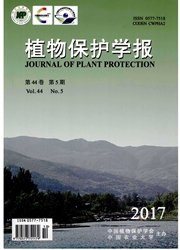

 中文摘要:
中文摘要:
为明确甘肃中部与周边地区小麦条锈菌种群的遗传结构及关系,利用SSR分子标记技术对采自甘肃、陕南、青海及新疆等7个地区共369份小麦条锈病菌标样的群体遗传结构进行了分析。结果表明,小麦条锈菌群体Nei’s基因多样性指数为0.39、Shannon信息指数为0.57,各地区条锈菌群体遗传多样性较为丰富,且在不同地区之间存在明显差异,7个条锈菌群体中以天水种群的遗传多样性相对较高,其Nei’s基因多样性指数为0.42、Shannon信息指数为0.61。该地区小麦条锈菌群体间和群体内都存在着一定的遗传分化,群体间遗传变异占总变异的2.24%,群体内遗传变异占总变异的97.76%。表明甘肃中部及周边地区小麦条锈菌群体存在一定的遗传分化,但遗传变异主要发生在群体内部;甘肃中部、陇南及陕南3地的小麦条锈菌种群遗传相似度较高,菌源交流密切。
 英文摘要:
英文摘要:
In order to reveal the population genetic structure and relationship of Puccinia striiformis f.sp.tritici (Pst) from central Gansu and the surrounding areas,369 Pst isolates were collected from seven areas,including Gansu,Southern Shaanxi,Qinghai and Xinjiang,and their population genetic diversity was investigated by SSR technique.The statistical analysis showed that Nei's gene diversity and Shannon' s information index of Pst populations were 0.39 and 0.57,respectively,which indicated that their population genetic diversity was rich in the seven areas.Furthermore,the genetic diversity of Pst populations from different areas was significantly different.The genetic diversity of Pst population from Tianshui of Gansu was much richer than that of other Pst populations,with it's Nei's gene diversity and Shannon' s information index of 0.42 and 0.61,respectively.In addition,analysis of AMOVA showed that 2.24% of the total genetic variation existed among the populations,while 97.76% of the total variation was present within the population.These results indicated that the Pst populations possessed relatively high level of genetic diversity but a lower genetic differentiation in central Gansu and the surrounding areas,and the main genetic variation was derived from within the population.The genetic similarity of Pst populations from the central area of Gansu,Longnan and Southern Shaanxi were very high,and the Pst strains intercommunicated closely in the three areas.
 同期刊论文项目
同期刊论文项目
 同项目期刊论文
同项目期刊论文
 期刊信息
期刊信息
